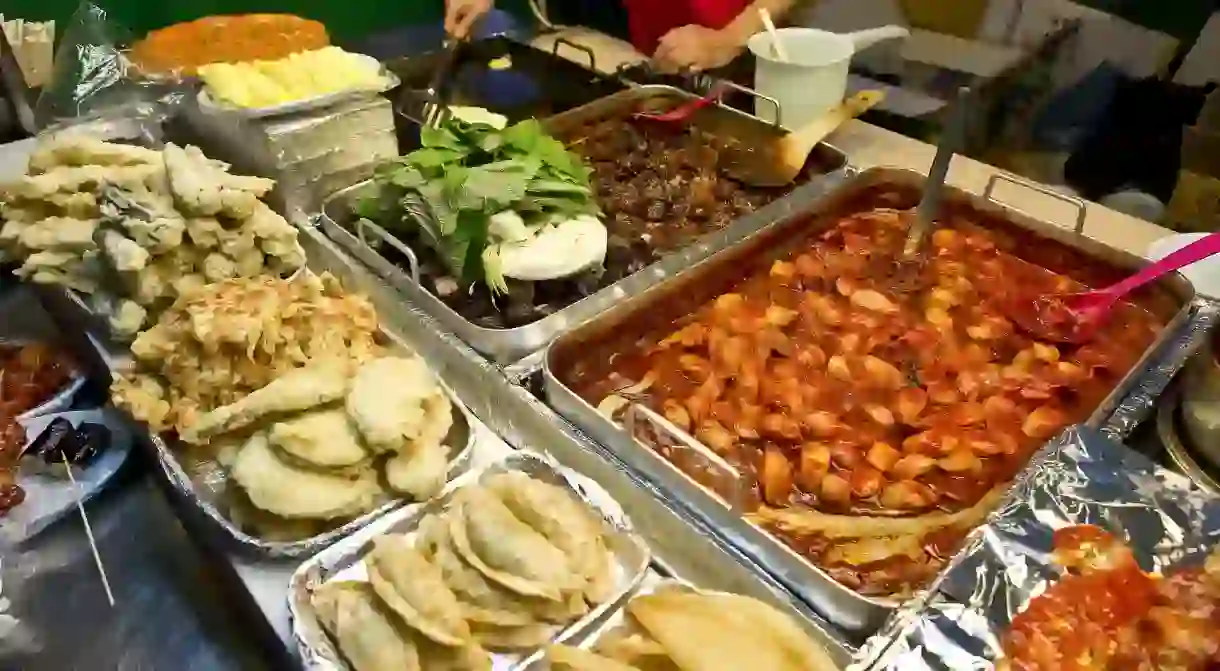A Guide to Eating Street Food in Busan

Walk through any busy street, take a trip to a mall, or transit through a medium-sized subway station anywhere in Korea, and you’ll see street food. Whether it’s fishcakes sold in their own soup at a specialty shop, or spicy tteokbokki served with soju at a pojangmacha (a roadside covered stall) street food is ubiquitous — and delicious. Here’s our guide to the best things to buy in Busan, and where to find them.
What to eat
Tteokbokki
You’ll see tteokbokki all over Korea; large pans full of spicy, bright red sauce containing finger-size rice cakes and sliced-up fish cakes. It’s so popular that many restaurants also serve a version.
Fish cakes
Busan fish cakes are known to be especially delicious, due to the city’s booming seafood trade. Also called eomuk, you’ll see them all over the city concertinaed onto skewers and cooked in fish cake soup (eomuk-guk; when you eat fish cakes, don’t forget to ask for a cup of the warm broth).

Ssiat hotteok
Hotteok, a sweet filled pancake, is popular all over Korea. Ssiat hotteok is a variation on this which is particular to Busan; the deep-fried dough is stuffed with chopped nuts and seeds, and brown sugar syrup. It’s cooked fresh and served piping hot.
Fritters
Like the Japanese tempura, Korean fritters are various vegetables and seafood which have been dipped in batter and deep-fried. They’re eaten with soy sauce (and ideally soju) at a pojangmacha. Options always include sweet Korean squash, shrimp, and egg. Rolled-seaweed fritters are vegetarian, as they’re stuffed not with seafood, but with dangmyeon, or glassy rice noodles. The stall-holder will normally give you small tongs to eat them with, but you can also ask for wooden chopsticks if you’d prefer.
Buchimgae
Buchimgae is the umbrella term for a number of Korean pancakes, including pajeon (seafood and green onion pancake), bindae-tteok (mung bean pancake) and kimchi-buchimgae, or kimchi-jeon. The ones you’ll see most of in Busan are green and red; the green pancakes are filled with vegetables, and the red ones are kimchi pancakes, or sometimes mung bean pancakes. They’re all made from a thick batter, which is then pan-fried. To eat, the buchimgae are cut into small pieces and served with soy sauce for dipping.
Skewers
Dakkochi (Korean marinated skewered chicken) is the most common iteration of this popular street food. You can also find lots of other types of meat, including artistically-sliced hot dogs. The common link between them is that they’ve been put on a skewer and grilled to perfection.

Sundae
The Marmite of Korean street food, sundae is a rich, dark, blood sausage which was traditionally eaten during Korean celebrations and holidays. It’s made by stuffing blood, meat or dangmyeon and vegetables into long tubes of pork intestine. Sundae is similar to the British dish black pudding, and has an equally strong flavour.
Mandu
Mandu are Korean-style dumplings, usually filled with finely-chopped vegetables and meat, and steamed, boiled or fried. They’re served with soy sauce and chilli for dipping. Whilst most mandu contain meat and thus aren’t vegetarian-friendly, some only contain vegetables; it’s worth asking the stall-holder for the ingredients.
Gimbap
Gimbap is one of Korea’s easiest street foods to eat; like sushi, it’s made by rolling up rice and fillings in a seaweed wrap. Street food versions tend to be cylindrical, but convenience stores sell a triangular version which is great food for on-the-go. Some stalls will roll your gimbap to your specifications, so you can choose your own fillings.

Where to eat it
BIFF Square
The original home of Busan International Film Festival (BIFF), this square is now one of Busan’s street food hotspots. You can buy all the Korean street food your heart desires here (there are a couple of stalls which sell especially good ssiat hotteok) and also a range of international foods, from Taiwanese peanut pancakes to Turkish kebabs. The area is always busy, and popular with Busanites and visitors alike.
Haeundae Market
Walk from Haeundae subway station towards the beach, and Haeundae Market will be on your left. Stalls here sell standard Korean street food, with an emphasis on seafood; think fish cakes, fritters, tteokbokki and pancakes. The menu is especially easy to navigate for foreign tourists, as signs above the stalls display names and prices in English.
Seomyeon
This busy downtown area has a number of street food vendors, mostly selling their wares from street side stalls or moveable pojangmachas. They tend to congregate in areas a little outside the shopping hotspots; try the street beside the Lotte Mall, Seomyeon-ro 68 beon-gil, or simply follow your nose through Seomyeon’s streets.













